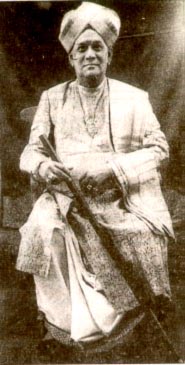
Harikesanallur Muthiah Bhagavathar (15 Nov 1877 – 30 Jun 1945)
Sri T.N.Seshagopalan (TNS) gave a lecture demonstration on Sri Harikesanallur Muthiah Bhagavathar and his compositions on the 15th of Aug 2006 at the Bangalore Gayana Samaja auditorium as a part of the Gayana Samaja’s 38th Music Conference. Sri Ramanathapuram C.S. Sankarasivam, who was the guru of TNS, was the foremost disciple of Muthiah Bhagavathar.
The lecture demonstration was very educative and showed how much knowledge TNS has about both the theoretical and the practical aspects of music. I am including the notes I took during the lec dem below.
TNS started the lec dem with Sri Vedanta Desikan‘s slOkam on Lord Hayagriva “gyAnanda mayam dEvam” sung in the rAgA yamunAkalyAni. The day being the Indian Independence Day, he then sang Subramanya Bharati’s composition “pArukuLLE nalla nAdu” in rAgA jOnpuri. Here are excerpts from the lec dem (as delivered by TNS):
- “The tamil work “silappadigAram” depicts the well developed music in India as early as 4 BC/2 AD.
- In the 18th/19th century, there were many seats of music and among them Mysore played a vital role in patronising music and musicians …… Harikesanallur Muthiah Bhagavathar was born in Tirunelveli district down south in Tamil Nadu. He was a great exponent of music and outstanding “harikathA” exponent of distinguished merit … the most exemplary contribution made by him through his compositions was when he was in Mysore.
- Muthiah Bhagavathar was a prolific composer …. he has composed many different types of compositions …. he composed many swarajatis, gItams, lakshana gItams … some of them are not there in print and are available only in parts. We have had to collect them and try to make a reasonable composition. Many compositions of his are scattered and available with different shishyAs (students) of his at different places.
- The varnams of Muthiah Bhagavathar were composed on traditional lines
- At the same time, he introduced new, innovative techniques of vAdi samvAdi (consonant dissonance) …… vAdi samvAdi in prayOgA too and not in swaram only. Example of vAdi samvAdi:In sAvEri Adi tala varnam sarasuda‘s charanam “dAnIpai nEnarUna IvEla“, the composer has started in dhaivatham (at dA of dAnIpai) and landed in rishabam (at rU of nEnarUna) in vAdi samvAdi
- In the sudha dhanyAsi varnam “shrI rAjamAtangi“, the third ethukadai “M G S, S N P M G, S G M P N S G, N S, P N, M P, G M P N S G, G S N P M” the next starting point of each swara combination is the sthAyi swaram of the very same swara where it ends (not like M G S, P M G, N P M, S N P …). The music flows very well this way. There are so many beauties of each such composition of Sri Muthiah Bhagavathar.
- He has composed many ata tAla varnams. The speciality of his ata tala varnams is that he has incorporated the swaras in the sAhitya too. In the anupallavi of mOhana ata tAla varnam “manamOhana” which was composed during my guru’s (Sri Sankarasivam) arangEtram before the Raja Muthuramalinga Sethupathi of Ramnad, the sAhityam comes like this: “gAnalOla muddu rAmalinga rAjarAjEshwarA sEtupatIndrA”. In the third ethukada swara, sudha swarAksharam comes: “dAdA (great person .. not today’s dada 🙂 ) , sagasa dAdA (easily approachable great person), pAri dAdA (pAri = pAril = in this world …. you are the patron of this world), sagA (friend to everybody), sariga pAgadA (wearing pagadi decorated with zaris), paridA (between the horses?), garidA (inbetween the elephants?), padA gadA (riding a palanquin?), dArIda, rIga.. dA, pA da parigari (friend to me in all ways, to share the happiness and sorrows), pAda“
- He made daru varnams famous. Pada varnams were already famous because of their usage in regular dance performances in the palaces. Daru varnams are special type of varnams in whose mukthAyi swarams, there are first the swarA passages, followed by the jatis which are then followed by the sAhitya. An example is the daru varnam “mAtE malayadvaja” in rAgA kamAsu (which when repeatedly spelt becomes sukama = sugama !!):
- Swara: DaDa NDDN DDND DNPM’ | DaDa NRSN SDNS DPMM ||
DaDa NGRN RSND PNDM | DaDa MGMP MPDD NNDM ||
DaD RSNDN DaD MDNMN | DaD SSPDN DaD MGRSN ||
DaDP DaDN DaDS DaRD | .MGR SNDa NSNN DDPM || - Jati: thAmthAm thakajoNu dadanida dimithaka | dAdA kukuthari thajaNutha dapamama ||
dAdA nigarini risadhimi tharikita | jamjam thakitatha kukuthari Namthari ||
dAthathin ginathari jEkumada nithaka | Namthasa sathimitha thomthadi mithakita ||
dAdapa dAdatha rEkusa dArijam |.magari sanidA nisanini dadapama || - SAhityA: dAdA sakalaka lAnipu Nachatusa | dAdA vividama dasamaya samarasa ||
dAdA sulabhahru dayamadu ravachana | dAdA sarasaru chirathara swaralaya ||
gItasu kadanija bhAvara sikavara | dAdama hisU.ra nAdanAl .vadisri ||
krishnarA jEndrara dAyEsa dA.bO | rEmahithE harikE samanOha rasadayE ||
You have to sing 2nd kAlam for all this – that is the gAna kramA, else it will become gAna akramA 🙂
- Swara: DaDa NDDN DDND DNPM’ | DaDa NRSN SDNS DPMM ||
- When it comes to varnam, his compositions have so many colors !!!!“

Leave a reply to subin kk Cancel reply